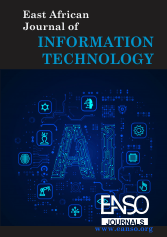Leveraging Artificial Intelligence for Land Use/Land Cover Change Detection to Improve Monitoring of the National Land Use Development Master Plan (NLUDMP) in the City of Kigali (CoK), Rwanda
Abstract
This research introduces a novel AI-driven framework, the Convolution Sequential Segmentation Network (ConvSegNet), which integrates Convolutional Long Short-Term Memory (ConvLSTM) networks for sequential multi-scale feature extraction from multispectral airborne and satellite imagery. ConvSegNet enhances high-resolution Land Use and Land Cover Change Detection (LULCCD), particularly for monitoring urban expansion and agricultural encroachment in Kigali, Rwanda. Using multi-temporal satellite imagery from 2009, 2020, and 2024, this study offers a detailed analysis of spatial and temporal LULC dynamics, capturing subtle changes that conventional methods often miss. ConvSegNet’s integration of spatial and temporal dependencies improves the detection of land cover transformations, such as urban sprawl and agricultural encroachment into forested areas. A key innovation is its ability to distinguish previously undifferentiated land cover classes, such as built-up areas and road networks, which traditional models have struggled to classify. The model demonstrated high accuracy, achieving 92% for urban areas, 85% for agricultural land, and 75% for forested regions. The results show significant LULC changes: agricultural land decreased from 70.68% (1,419.52 km²) in 2009 to 60.92% (1,213.49 km²) in 2024, while built-up areas grew by 32.71%, means from 0.81% (16.09 km²) in 2009 to 3.46% (69.38 km²) in 2024. Forest cover declined by 202.23 km², from 16.42% (327.27 km²) in 2009 to 11.15% (222.92 km²) in 2024, indicating significant environmental degradation in the city of Kigali. Despite high classification accuracy, ConvSegNet showed limitations in detecting gradual land cover transitions, especially in forests affected by agricultural encroachment. This highlights the need for further model improvements, including higher temporal resolution data and additional spectral features. Overall, the study provides valuable insights for sustainable land management in Rwanda, supporting the National Land Use Development Master Plan (NLUDMP) with advanced AI tools for monitoring LULC changes, mitigating urban sprawl, and enhancing environmental conservation efforts.
Downloads
References
Brown, C. F., Brumby, S. P., Guzder-Williams, B., Birch, T., Hyde, S. B., Mazzariello, J., Czerwinski, W., Pasquarella, V. J., Haertel, R., Ilyushchenko, S., Schwehr, K., Weisse, M., Stolle, F., Hanson, C., Guinan, O., Moore, R., & Tait, A. M. (2022). Dynamic World, Near real-time global 10 m land use land cover mapping. Scientific Data, 9(1), 251. https://doi.org/10.1038/s41597-022-01307-4
Campos-Taberner, M., García-Haro, F. J., Martínez, B., Izquierdo-Verdiguier, E., Atzberger, C., Camps-Valls, G., & Gilabert, M. A. (2020). Understanding deep learning in land use classification based on Sentinel-2 time series. Scientific Reports, 10(1), 17188. https://doi.org/10.1038/s41598-020-74215-5
Díaz, S., Fargione, J., Chapin, F. S., & Tilman, D. (2006). Biodiversity loss threatens human well-being. In PLoS Biology (Vol. 4, Issue 8, pp. 1300–1305). Public Library of Science. https://doi.org/10.1371/journal.pbio.0040277
Mugiraneza, T., Nascetti, A., & Ban, Y. (2019). WorldView-2 data for hierarchical object-based urban land cover classification in Kigali: Integrating rule-based approach with urban density and greenness indices. Remote Sensing, 11(18). https://doi.org/10.3390/rs11182128
Mugiraneza, T., Nascetti, A., & Ban, Y. (2020). Continuous monitoring of urban land cover change trajectories with Landsat time series and landtrendr-google Earth engine cloud computing. Remote Sensing, 12(18). https://doi.org/10.3390/RS12182883
Müller, C., & Robertson, R. D. (2014). Projecting future crop productivity for global economic modelling. Agricultural Economics, 45(1), 37–50. https://doi.org/https://doi.org/10.1111/agec.12088
Nduwayezu, G., Sliuzas, R., & Kuffer, M. (2017). Modeling urban growth in Kigali city Rwanda. Rwanda Journal, 1(1S). https://doi.org/10.4314/rj.v1i2s.7d
United Nations, “World Population Prospects 2019: Highlights,” United Nations Department of Economic and Social Affairs, Population Division, (2019). United Nations.
Van Dijk, M., Morley, T., Rau, M. L., & Saghai, Y. (2021). A meta-analysis of projected global food demand and population at risk of hunger for the period 2010–2050. Nature Food, 2(7), 494–501. https://doi.org/10.1038/s43016-021-00322-9
Yu, L., Wang, J., Li, X. C., Li, C. C., Zhao, Y. Y., & Gong, P. (2014). A multi-resolution global land cover dataset through multisource data aggregation. Science China Earth Sciences, 57(10), 2317– 2329. https://doi.org/10.1007/s11430-014-4919-z
Copyright (c) 2025 Yvonne Akimana, Ntwali Didier, PhD

This work is licensed under a Creative Commons Attribution 4.0 International License.




























